By Louis Cahill
Understanding these 5 common bonefish behaviors will help you catch a lot more fish.
I love bonefishing! There’s a shocker. Every species has unique characteristics which make them fun or challenging to catch. The chess game of feeding a sipping brown trout, the mix of finesse and raw power required to boat a tarpon and the zen of swinging a fly to a fresh steelhead are the parts of the game that hold the reward. One of my favorite games to play is the one we play with bonefish.
They don’t have the power of a tarpon or the mystique of a permit, the romance of a steelhead or the selectiveness of an educated trout, but they remain a challenging and rewarding species. More than the pursuit of any other fish, bonefishing is a game of strategy and tactics. Their vigilance and behavior require the perfect presentation at the exact right time. For me, it never gets old.
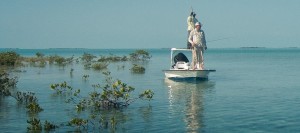 I had a day on my last trip to the Bahamas that was just about perfect. We were fishing deep in the backcountry on a high tide. Our guide poled the boat way back onto a flat that was sprinkled with mangroves. Single mangroves, clumps and mangrove islands, sometimes with just enough space to push the boat through. Puffy clouds blew over our heads.
I had a day on my last trip to the Bahamas that was just about perfect. We were fishing deep in the backcountry on a high tide. Our guide poled the boat way back onto a flat that was sprinkled with mangroves. Single mangroves, clumps and mangrove islands, sometimes with just enough space to push the boat through. Puffy clouds blew over our heads.
We’d use the mangroves for cover and take sniper-like shots at fish as they approached open areas. The fish would appear and disappear with the sunlight. Everything had to be timed perfectly to get the hookup, and once you did you’d better be ready for a fight. Keeping those fish out of the mangroves takes skill.
That’s just one of the endless scenarios you’ll find when bonefishing. The beauty of the game is that anything can happen. Bonefish can exhibit bizarre behavior and a wise angler expects the unexpected. That said, there are five very common behaviors you will see from bonefish and knowing how to present the fly in these situations will catch you a lot of fish. I’ll give you some guidelines but remember, it’s all about reading the fish’s behavior and adapting. Don’t be afraid to improvise. That’s what makes it fun.
5 common bonefish behaviors and some successful presentations.
Schooling
It’s very likely that you caught, or will catch, your first bonefish from a school. I’m not talking about small schools that you see roaming the flats but big schools of hundreds or even thousands of fish milling around using their numbers for safety. As you progress in your bonefish education, you get bored with fishing schools but for anglers new to bonefishing they are a golden opportunity. Fishing schools gives you the opportunity to develop skills like the strip set and fish fighting by hooking a lot of fish in a short time.
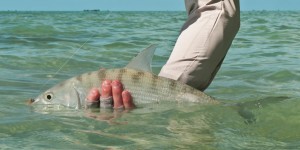 When they are schooled up, bonefish become more confident. They also become competitive, which gives you big edge. When presenting the fly to big schools, go for broke. Drop the fly right in the middle of the school. The school will part like the Red Sea but be patient. Let the fly sink. The school will close right back up on your fly, and when they do, a couple of strips is all you’ll need.
When they are schooled up, bonefish become more confident. They also become competitive, which gives you big edge. When presenting the fly to big schools, go for broke. Drop the fly right in the middle of the school. The school will part like the Red Sea but be patient. Let the fly sink. The school will close right back up on your fly, and when they do, a couple of strips is all you’ll need.
Once in a while you’ll see what’s called a mud. That’s a big school of fish feeding aggressively. You’ll see a big milky area with fish flashing in it. There are some well known sayings about muds. “Friends don’t let friends fish muds.” “Getting caught fishing muds is like getting caught masturbating.” You won’t see accomplished anglers fishing muds, but if you’re new to bonefishing, don’t pass up the chance. It’s your one free pass to catch as many fish as you’re able. Use it to work on your retrieve, strip set, fish fighting and line managing skills. And have fun, just drop the rod when your mom walks in.
Hauling Ass
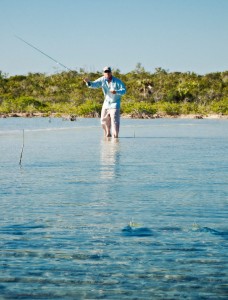 One of the most common bonefish behaviors. Bonefish can swim 35 MPH. Just because they’re hauling ass doesn’t mean they can’t be caught. It’s just a challenge. I have caught a lot of bonefish that saw the boat and hauled ass by dropping a long cast in front of them. The trick is you have to lead them by 30-40 feet. They will close that gap quickly at warp speed and the long lead gives your fly time to sink.
One of the most common bonefish behaviors. Bonefish can swim 35 MPH. Just because they’re hauling ass doesn’t mean they can’t be caught. It’s just a challenge. I have caught a lot of bonefish that saw the boat and hauled ass by dropping a long cast in front of them. The trick is you have to lead them by 30-40 feet. They will close that gap quickly at warp speed and the long lead gives your fly time to sink.
As a general rule, the faster a fish is swimming, the straighter a path he will take. Try to intercept his course by crossing his path by about half the length of your leader. A simple lead and cross presentation. If the fish is swimming directly away from you, try to drop the fly to the near side of him by five feet or so. That will often get his attention.
Traveling
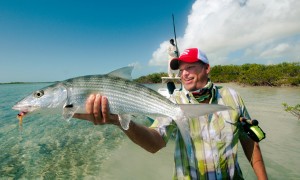 A traveling fish moves like he has a purpose. This fish might be swimming 10-15 MPH and traveling in a fairly straight path. It will likely be a small school rather than a single. These fish are not actively feeding but bonefish have a very high metabolism and don’t like to pass up a meal.
A traveling fish moves like he has a purpose. This fish might be swimming 10-15 MPH and traveling in a fairly straight path. It will likely be a small school rather than a single. These fish are not actively feeding but bonefish have a very high metabolism and don’t like to pass up a meal.
In this case you want to lead the fish by 10-20 feet. Again, based on their speed, you want the fly to sink before they close the gap. If they are moving laterally to your position, use a simple lead and cross presentation. You’ll often see traveling fish coming straight for you. This is a pretty forgiving setup. Just drop the fly in front of them and let them come to it. Try to hit them with a medium to long cast so you have time for a plan B.
Hunting
Here’s where things get fun. Hunting fish are actively feeding so it’s a high percentage shot, but not without its challenges. When bonefish hunt, they meander around the flat, sniffing and looking for food. They change direction frequently and move more slowly, so you’ll have to put the fly closer to them. Lead them too far and they’ll likely turn off course before they see your fly.
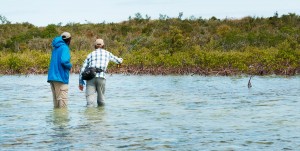 When they are in hunting mode, all of their senses are on high. This is what makes it tricky. You have to put the fly close enough to be in play without spooking a hyper-alert fish. It’s not as simple as me telling you how far to lead the fish. There are a lot of variables to account for.
When they are in hunting mode, all of their senses are on high. This is what makes it tricky. You have to put the fly close enough to be in play without spooking a hyper-alert fish. It’s not as simple as me telling you how far to lead the fish. There are a lot of variables to account for.
The important thing is to picture what the fish sees. Is it calm day? If the water is flat calm, any surface disturbance will be very visible, and worse, loud as hell. You’ll need a light fly and you’ll have to drop it very softly. You’ll have to lead the fish a little more or use structure to hide your presentation. Drop your fly on the far side of a small point or mangrove as the fish approaches. You’ll have to make longer casts too, to avoid the fish seeing the boat. If you have some wind and the surface of the water is broken, things will be easier. You can get closer to the fish and drop your fly much closer to him.
 The angle of the sun makes a big difference, too. If the sun is high, the fish will have good visibility. He’ll be able to see the fly from further away. He’ll be able to see you from further away too, so you’ll have to be stealthy. If the sun is low, the fish’s visibility will depend on the angle. If the sun is at his back he’ll have a good view, but if it’s in his face his visibility will be much less. You have to put the fly much closer to him or he’ll miss it.
The angle of the sun makes a big difference, too. If the sun is high, the fish will have good visibility. He’ll be able to see the fly from further away. He’ll be able to see you from further away too, so you’ll have to be stealthy. If the sun is low, the fish’s visibility will depend on the angle. If the sun is at his back he’ll have a good view, but if it’s in his face his visibility will be much less. You have to put the fly much closer to him or he’ll miss it.
Two rules to keep in mind are, with wind, the better you can see the fish the better he can see you and the longer you should lead him. With low sun, the better you can see the fish, the less he can see you, and the closer you should lead. Remember, if the sun is at your back, it’s probably in his eyes. These factors should be considered in any presentation, they are just most crucial here.
Tailing
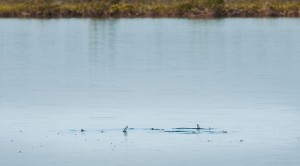 This is the holy grail of bonefish shots and definitely a good news / bad news scenario. Tailing fish are feeding aggressively. They are in an eating mood. Their faces are down in the sand and they’re focused. That’s the good news. The bad news is, you will really have to be on your game to catch them.
This is the holy grail of bonefish shots and definitely a good news / bad news scenario. Tailing fish are feeding aggressively. They are in an eating mood. Their faces are down in the sand and they’re focused. That’s the good news. The bad news is, you will really have to be on your game to catch them.
Usually, tailing fish are not moving around much. They are working methodically. This will give you time to plan your approach, but it means you will have to land the fly very close to them. Within a couple of feet. It will have to land very softly. You’ll need a light fly and a special cast that takes the energy out of the line before the fly lands.
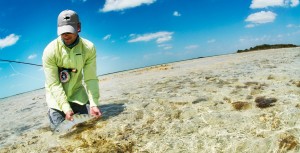 There are two good casts that work. A “Tear Drop Cast” is a gentle overhead cast in which you drop the rod tip on the delivery. It creates a wide lazy loop without a lot of energy. It takes a little practice but works well. What I like is a low side-arm cast. I shoot the fly to the fish and use gentle pressure with my line hand to stop the fly a couple of feet above the water and let it drop gently.
There are two good casts that work. A “Tear Drop Cast” is a gentle overhead cast in which you drop the rod tip on the delivery. It creates a wide lazy loop without a lot of energy. It takes a little practice but works well. What I like is a low side-arm cast. I shoot the fly to the fish and use gentle pressure with my line hand to stop the fly a couple of feet above the water and let it drop gently.
You usually find fish tailing on calm days when the water is flat. It goes without saying that the presentation must be delicate. One thing you should pay close attention to is the angle of the light. If the sun is out, your line will cast a strong shadow on the bottom. The fish are looking down and that will spook them every time. Before you cast, be sure your line is not approaching the fish from the same side as the sun. You may have to make a backhand cast to get the right angle.
These tips are part of my Bonefish 101 class and they are designed to give anglers an idea of what to expect on the flats and how to react. They will put you on a lot of bonefish, but they are in no way everything you will see from bonefish. If you fish them for your whole life they will still surprise you. That’s what keeps it fun! Pay attention to fish’s behavior, assess the conditions, adapt your presentation and stay on your toes. That’s the game of bones.
Louis Cahill Gink & Gasoline www.ginkandgasoline.com hookups@ginkandgasoline.com Sign Up For Our Weekly Newsletter!
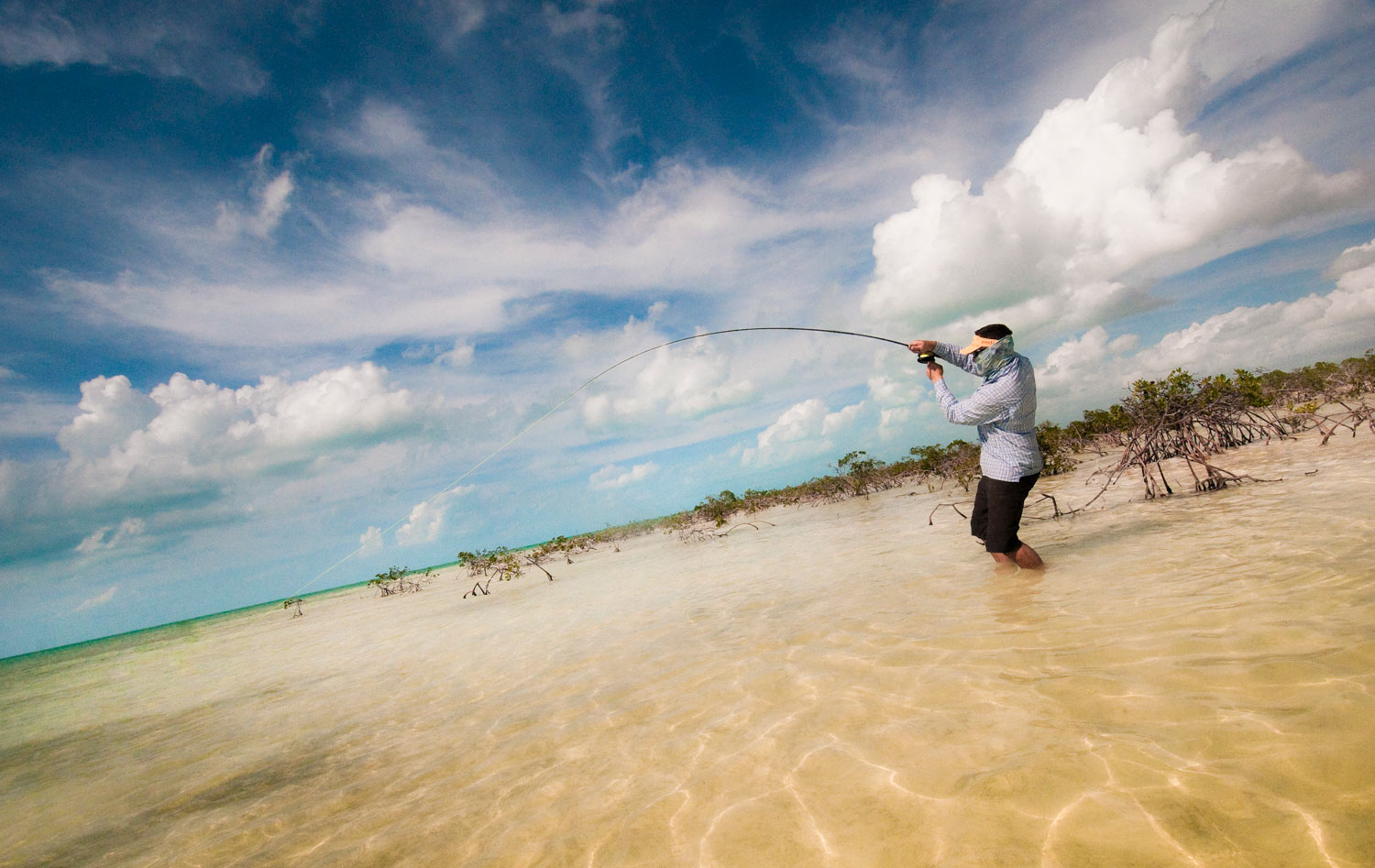
Doesn’t only Every species has unique characteristics which make them fun or challenging to catch ?
Of course. And doesn’t everyone have their favorites?
Pingback: Gink & Gasoline and some Bonefish Knowledge | Bonefish on the Brain
Any difference fishing for bones in Bahamas vs Belize?
Pingback: Tippets: Fly Fishing Therapy, Flies for Cold Weather, Playing the Bonefish Game | MidCurrent
great thanks
There is so much info in this article that I would never have thought of on my own. Your content gives readers things to think about in an interesting way.
Kulfi Kumar Bajewala
I always enjoy your well-written and very informative articles on Your,’s, Lefty Kreh’s& my favorite sport fish- Bones! Keep ’em comin!